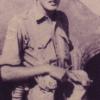Pat Conn's memories of flying in the Blackburn Beverley
A few more recollections. The Beverley gave you two options, an entirely pax load of 70 or 80 if you squeezed. In this you had the normal starboard and port sticks in the freight bay of sixty, then another 20 could be crammed into the boom, formed from an extra 10 for each stick. Usually though it was only another extra 10 , five to tack on to the freight bay sticks. They would emplane as a `centre stick first, leave their equipment containers in the centre of the freight bay and climb up the sides of the Beverley through the port and starboard hatches next to the crew compartment/flight deck, complete with main and reserve parachutes. Not easy at all! On `prepare for action’ the reverse would happen, climb down, link up with your weapons container, hook up and` tell off’ as a centre stick. When port and starboard were being dispatched the centre stick would follow on to their appropriate door, first 5 or 10 to starboard, second 5 or 10 port. When rigged for Heavy drop, support company pax (de-riggers and drivers) would be carried in the boom and jump through the hatch to be close to the loads. Not only was this a much better experience leaving the aircraft (like sitting in an armchair) as you dropped into the slipstream but also you had a longer flight usually 1,000ft asl because the loads on the MSPs needed that time to deploy. This was often why heavy drop DZs were consecutive or parallel rather than superimposed on the troops DZ. I seem to recall that the bulk of the Beverleys at RAF Muharraq were found from 30 Sqn whose base was at RAF Eastleigh in Kenya. Occasionally we would get rotations in the flight aircraft from Eastleigh or RAF Khormaksar in Aden. If it was the latter, it may have been found from 84 Sqn. Memory fades at this point, but they were crucial in the move of D Company Group 2 PARA to Aden for Op Parthenon which eventually morphed in Op Shed…Zanzibar which never happened from the airborne point of view.
The aircraft was built at the Blackburn Aircraft works in Brough outside Hull. One of the design team, Harold Brumby, was a part of the design team and the family were the best friends with my in-laws who also lived in Elloughton-cum-Brough close to the airfield and factory. Harold was a part of the design team for the integration of the engines. He always maintained that the aircraft should have been fitted with the Rolls Royce engines and the wing design changed because the Bristol Centaurus were underpowered and did not do the job as efficiently…I think that generally the RAF agreed. He also said that the overall design concept borrowed a lot form the WW ll Hamilcar glider, and if you compare photos, you can see the similarities. Harold then moved on to the design team of the Blackburn Buccaneer naval fast jet, something with which he was far happier.
I was very fond of the Beverley, hardly a stunner, but a fantastic workhorse for its time.
The Beverley XB259 (the last Beverley)
I know this aircraft rather well. It used to be outside at the Transport Museum in Beverley before it closed and was bought and moved to Fort Paull. In the first instance, I believe that General Mike Gray was involved in its procurement from MoD and got it a home in Beverley. As you will be aware General Mike lived at Pocklington and his funeral was held in Beverley Minster. As far as I know this is the last survivor and we of a certain vintage will have many fond memories of it in the 1960’s. The routine from Bahrain when the para battalion groups were rotated through there was that a flight of these (four, sometimes five) were under command at RAF Muharraq with a company group at 2 hrs notice to redeploy to Kuwait also at the airfield. We could use one of them at a time for continuation
parachuting.
The procedure was very early reveille, emplane with RMO and DZ party, fly out to the Trucial States (Jebel Ali outside Dubai) land on the desert (normally Juweiza) and dump the DZ party, take off again, circuit, parachute, aircraft lands again, emplane with all our kit, take off again and back in Bahrain for a late breakfast! The aircraft was a true workhorse even though it was very underpowered and did not have the range. It required two refuels to fly from Bahrain to Aden often at Sharjah and Salalah in Oman and sometimes Socotra in the Gulf of Aden. All happy days!
Source:
With thanks to Pat Conn of the Airborne Network
Read More




Latest Comments
There are currently no comments for this content.
Add Comment
In order to add comments you must be registered with ParaData.
If you are currently a ParaData member please login.
If you are not currently a ParaData member but wish to get involved please register.